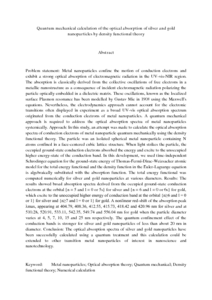Citation
Gharibshahi, Elham and Saion, Elias
(2010)
Quantum mechanical calculation of the optical absorption of silver and gold nanoparticles by density functional theory.
Physics International, 1 (1).
pp. 57-64.
ISSN 1948-9803
Abstract
Problem statement: Metal nanoparticles confine the motion of conduction electrons and exhibit a strong optical absorption of electromagnetic radiation in the UV-vis-NIR region. The absorption is classically derived from the collective oscillations of free electrons in a metallic nanostructure as a consequence of incident electromagnetic radiation polarizing the particle optically embedded in a dielectric matrix. These oscillations, known as the localized surface Plasmon resonance has been modelled by Gustav Mie in 1908 using the Maxwell's equations. Nevertheless, the electrodynamics approach cannot account for the electronic transitions often displayed in experiment as a broad UV-vis optical absorption spectrum originated from the conduction electrons of metal nanoparticles. A quantum mechanical approach is required to address the optical absorption spectra of metal nanoparticles systemically. Approach: In this study, an attempt was made to calculate the optical absorption spectra of conduction electrons of metal nanoparticle quantum mechanically using the density functional theory. The particle was an isolated spherical metal nanoparticle containing N atoms confined in a face-centered cubic lattice structure. When light strikes the particle, the occupied ground-state conduction electrons absorbed the energy and excite to the unoccupied higher energy-state of the conduction band. In this development, we used time-independent Schrodinger equation for the ground-state energy of Thomas-Fermi-Dirac-Weizsacker atomic model for the total energy functional and the density function in the Euler-Lagrange equation is algebraically substituted with the absorption function. The total energy functional was computed numerically for silver and gold nanoparticles at various diameters. Results: The results showed broad absorption spectra derived from the occupied ground-state conduction electrons at the orbital {n = 5 and l = 0 or 5s} for silver and {n = 6 and l = 0 or 6s} for gold, which excite to the unoccupied higher energy of conduction band at the orbital {n≥6 and l = 0 or 1} for silver and {n≥7 and l = 0 or 1} for gold. A nonlinear red-shift of the absorption peak λmax, appearing at 404.79, 408.36, 412.55, 415.73, 418.42 and 420.96 nm for silver and at 510.28, 520.91, 533.11, 542.35, 549.74 and 556.04 nm for gold when the particle diameter varies at 4, 5, 7, 10, 15 and 25 nm respectively. The quantum confinement effect of the conduction bands is stronger for silver and gold nanoparticles of less than about 20 nm in diameter. Conclusion: The optical absorption spectra of silver and gold nanoparticles have been successfully calculated using a quantum treatment and this calculation could be extended to other transition metal nanoparticles of interest in nanoscience and nanotechnology.
Download File
![[img]](http://psasir.upm.edu.my/16416/1.hassmallThumbnailVersion/Quantum%20mechanical%20calculation%20of%20the%20optical%20absorption%20of%20silver%20and%20gold%20nanoparticles%20by%20density%20functional%20theory.pdf)  Preview |
|
PDF (Abstract)
Quantum mechanical calculation of the optical absorption of silver and gold nanoparticles by density functional theory.pdf
Download (191kB)
| Preview
|
|
Additional Metadata
Actions (login required)
 |
View Item |

